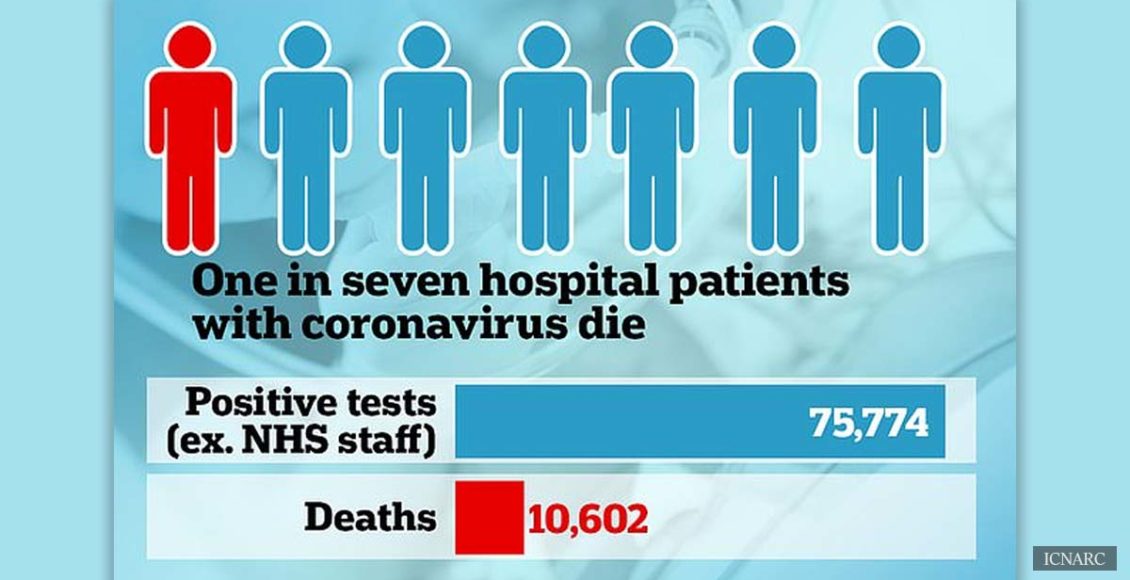One in seven coronavirus hospitalized patients in the UK have died – as have half of the intensive care patients

Official statistics have estimated that in the UK, one in every seven people hospitalized with the coronavirus will die with it.
By April 14th, there are already 11,329 deaths from the novel COVID-19. The total confirmed coronavirus cases in the UK are 88,621. The fatality rate is approximately 13 percent.
Intensive care units(ICU) report that the death rate for critically ill patients, many of whom need ventilators, is considerably higher at 51.6 percent, according to Mail Online.
Lung failure is the most common life-threatening problem thousands of coronavirus patients in British hospitals face. In this condition, the body cannot draw enough oxygen into the blood. Scientists have found that COVID-19 patients also suffer shock and heart or kidney failure in up to a third of cases.
Since the beginning of the outbreak in February, tens of thousands of UK residents have been hospitalized. At first, the Government responded to the pandemic by testing every citizen with suspicious symptoms. However, they almost stopped testing people outside of hospitals since March 12. By this time there were 596 positive tests and 10 deaths.
Now, the numbers are even more terrifying, and the fatality rate reaches nearly 14 percent. Nonetheless, this isn’t an absolutely correct reflection of how deadly the virus actually is. Hundreds of thousands, if not millions of British residents got only a mild illness, recovering at home as if they had the flu.
Experts foresee the actual death rate to be below 1 percent if the real number of infected people is ever counted.
This includes Professor Chris Whitty, the Government’s chief medical adviser, and scientists at Imperial College London.
Although the vast majority of coronavirus patients need only support to manage their symptoms or treatment for other infections to recover, others need special intensive care.
The Intensive Care National Audit & Research Centre (ICNARC) claims that up to April 9th there was information available for 3,883 COVID-19 ICU admissions. More than half of those patients whose hospital treatment had ended have not survived, with 871 of them dying, and 818 being discharged alive. At the time the ICNARC report was published, 2,194 people were still hospitalized.
Moreover, only around a third of the patients who need respirators survive their hospital stay. While talking about the high fatality rate for the people needing lung support, Professor Duncan Young from the University of Oxford explained:
“The relative ineffectiveness of artificial ventilation might suggest that COVID-19 causes a particularly treatment-resistant form of pneumonitis. It is also possible that in some patients COVID-19 is causing multi-organ failure of which the respiratory failure is the presenting problem but may not always be the cause of death – but there are no data on this yet.”
Due to the fact that neither the Government nor NHS England publishes ongoing data about the total number of hospitalized coronavirus cases, the exact death rate is almost impossible to be calculated.
Besides, some of the individuals counted in the testing figures may be NHS staff who are not classified as hospital patients.
On Sunday’s daily Government briefing, Health Secretary Marr Hancock said that currently, there are nearly 19,000 COVID-19 hospitalized patients. However, the NHS is still coping and has more than 2,000 intensive care beds free.
However, medics and other healthcare workers are furious about the personal protective equipment shortage. Many of them admit they are forced to work without adequate protection. In response, Matt Hancock said that medical staff needs to be more economical while using equipment like masks, gowns, gloves, and goggles, so there could be enough for everyone.
The Nursing Standard states that two-thirds of the NHS nurses claim they don’t have enough PPE. One-third of them have used their own money to buy the needed equipment, while one-tenth tried to make their own.
Susan Masters, at the Royal College of Nursing, said:
“It is simply unacceptable that nurses are being forced to spend their own money to buy even what would be considered to be the bare minimum to protect themselves. We keep hearing that millions of pieces of equipment are being delivered but words are not enough. All nursing staff, no matter where they work, must feel safe and need action rather than assurances if they are to be able to do their jobs.”

